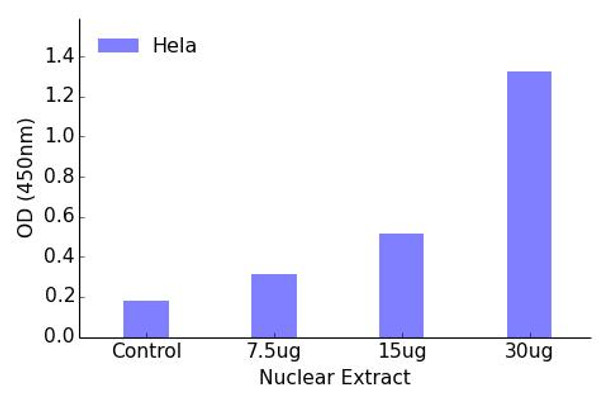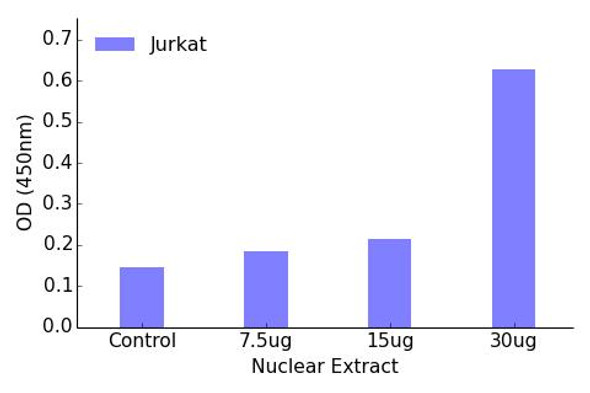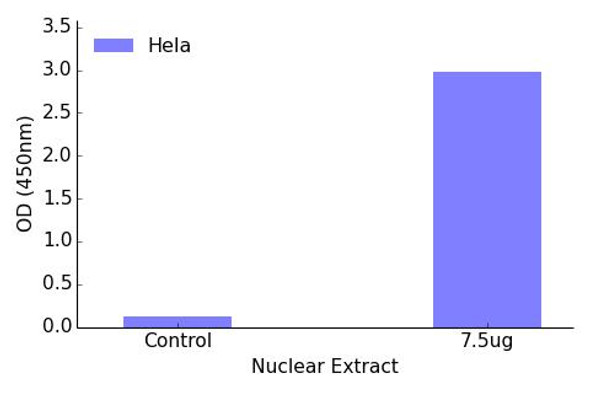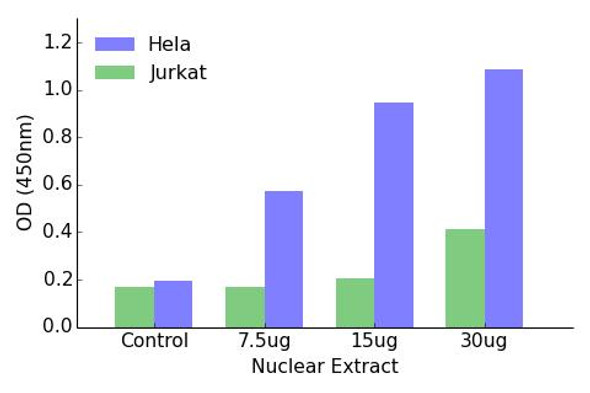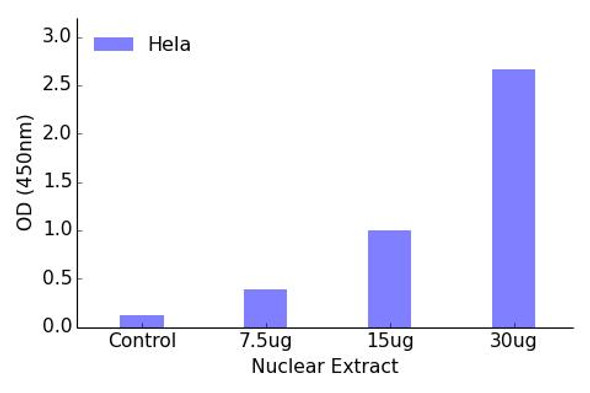RUNX3 Transcription Factor Activity Assay (TFAB00075)
- SKU:
- TFAB00075
- Product Type:
- ELISA Kit
- ELISA Type:
- Transcription Factor Assay
- Analytes:
- RUNX3
- Reactivity:
- Human
- Mouse
- Rat
Description
RUNX3 Transcription Factor Activity Assay
The Runx3 Transcription Factor Activity Assay Kit is a reliable and sensitive tool for measuring the activity of the Runx3 transcription factor in various sample types, including cell lysates and tissue homogenates. This kit utilizes a highly specific and robust assay design, ensuring accurate and reproducible results for your research needs.Runx3 is a key transcription factor that plays a critical role in regulating gene expression and cell development. Dysregulation of Runx3 has been implicated in various diseases, including cancer, immune disorders, and developmental abnormalities.
By accurately measuring Runx3 activity, researchers can gain valuable insights into the molecular mechanisms underlying these conditions and potentially identify novel therapeutic targets.With its ease of use and high performance, the Runx3 Transcription Factor Activity Assay Kit is an indispensable tool for studying the function of Runx3 in health and disease. Whether you are investigating molecular pathways, screening potential drug candidates, or evaluating therapeutic interventions, this kit provides the precision and consistency needed for meaningful results.
| Product Name: | RUNX3 Transcription Factor Activity Assay |
| Product Code: | TFAB00075 |
| Target: | RUNX3 |
| Synonyms: | Acute myeloid leukemia 2 protein, Core-binding factor subunit alpha-3, CBF-alpha-3, Oncogene AML-2, Polyomavirus enhancer-binding protein 2 alpha C subunit, PEA2-alpha C, PEBP2-alpha C, SL3-3 enhancer factor 1 alpha C subunit, SL3/AKV core-binding factor alpha C subunit |
| Reactivity: | Human, Mouse, Rat |
| Sample Types: | Nuclear or cell lysates |
The Assay Genie RUNX3 transcription factor activity assay allows for the detection and qualitative analysis of endogenous levels of activated transcription factors in a variety of nuclear and cell lysates
Assay Genie ELISA kits are designed to significantly reduce experiment time and ensure sensitivity and flexibility for high-throughput screening.
| Assay Time: | 4.5 hours |
| Detection Method: | Colorimetric 450 nm |
| Size: | 12 x 8-Well Microstrips |
| Storage: | 4°C for 6 months |
| UniProt Protein Function: | AML2: CBF binds to the core site, 5'-PYGPYGGT-3', of a number of enhancers and promoters, including murine leukemia virus, polyomavirus enhancer, T-cell receptor enhancers, lck, IL-3 and GM-CSF promoters. Heterodimer of an alpha and a beta subunit. The alpha subunit binds DNA as a monomer and through the Runt domain. DNA- binding is increased by heterodimerization. Interacts with TLE1 and SUV39H1. The tyrosine phosphorylated form (via runt domain) interacts with SRC (via protein kinase domain). Interacts with FYN and LCK. 2 isoforms of the human protein are produced by alternative splicing. |
| UniProt Protein Details: | Protein type:DNA-binding; Transcription factor Chromosomal Location of Human Ortholog: 1p36 Cellular Component: cytoplasm; nuclear chromatin; nucleus Molecular Function:protein binding; transcription factor activity Biological Process: chondrocyte differentiation; hemopoiesis; negative regulation of cell cycle; negative regulation of epithelial cell proliferation; negative regulation of transcription from RNA polymerase II promoter; ossification; peripheral nervous system neuron development; positive regulation of transcription, DNA-dependent; protein amino acid phosphorylation; regulation of cell differentiation; regulation of transcription from RNA polymerase II promoter; transcription from RNA polymerase II promoter |
| NCBI Summary: | This gene encodes a member of the runt domain-containing family of transcription factors. A heterodimer of this protein and a beta subunit forms a complex that binds to the core DNA sequence 5'-PYGPYGGT-3' found in a number of enhancers and promoters, and can either activate or suppress transcription. It also interacts with other transcription factors. It functions as a tumor suppressor, and the gene is frequently deleted or transcriptionally silenced in cancer. Alternative splicing results in multiple transcript variants. [provided by RefSeq, Mar 2016] |
| UniProt Code: | Q13761 |
| NCBI GenInfo Identifier: | 17368453 |
| NCBI Gene ID: | 864 |
| NCBI Accession: | Q13761.2 |
| UniProt Secondary Accession: | Q13761,Q12969, Q13760, B1AJV5, |
| UniProt Related Accession: | Q13761 |
| Molecular Weight: | 45,922 Da |
| NCBI Full Name: | Runt-related transcription factor 3 |
| NCBI Synonym Full Names: | runt related transcription factor 3 |
| NCBI Official Symbol: | RUNX3 |
| NCBI Official Synonym Symbols: | AML2; CBFA3; PEBP2aC |
| NCBI Protein Information: | runt-related transcription factor 3 |
| UniProt Protein Name: | Runt-related transcription factor 3 |
| UniProt Synonym Protein Names: | Acute myeloid leukemia 2 protein; Core-binding factor subunit alpha-3; CBF-alpha-3; Oncogene AML-2; Polyomavirus enhancer-binding protein 2 alpha C subunit; PEA2-alpha C; PEBP2-alpha C; SL3-3 enhancer factor 1 alpha C subunit; SL3/AKV core-binding factor alpha C subunit |
| Protein Family: | Runt-related transcription factor |
| UniProt Gene Name: | RUNX3 |
| UniProt Entry Name: | RUNX3_HUMAN |

